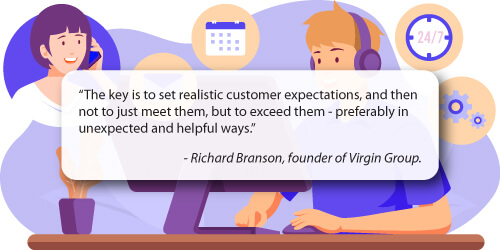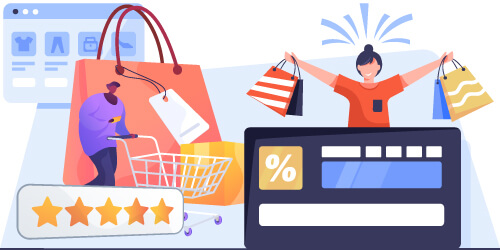Any customer entering your store expects you to meet their needs. These expectations could be related to your store's overall look and feel, how your staff interacts with them at checkout, or the products you stock. Whatever they are, you must live up to their expectations as best as possible. Sounds intimidating, right? Fortunately, there is a solution to lessen the anxiety: data-driven planograms.

Why are we so confident about using them to meet customer expectations? It’s because of the results we’ve experienced in delivering our category management solutions as a software solution or as part of our category management services offering. We deliver results.
So where do planograms come in? Below, we unpack five ways you can use planograms to meet and exceed customer expectations.

1. Design product flows and consumer decision trees
Put yourself in the shoes of your average shopper.
Would you like to walk into a store and then up and down an aisle looking for a product you know should be on the shelf? But you can't find it. Now let's say it's not only one item but a handful of products.
How frustrated would you be? Enough to walk out of the store, never to return? We wouldn't blame you.
There are not many things worse than having a poorly merchandised shelf because it can lead to stockouts and dissatisfied customers. It's where data-driven planograms can help you.
You can set up logical product flows and create consumer decision trees with data-driven planograms. Consumer decision trees, also known as product hierarchies, help you understand the buying habits of your customers and their decision-making process.
Just remember: your customers expect to find products quickly and easily. That’s possible when you implement planograms that reflect how customers shop in-store.

2. Stock the right products and know when to replenish
Have you ever walked past a product in a store and wondered why anyone would buy it? Then, three months later, you return to that store and see the items still on the shelf.
What about the opposite - you visit the same store looking for an item but can't locate it because it's out of stock? Now imagine this is a store that you work at. And your customers are experiencing this same frustration.

Stocking the right products goes a long way to avoiding this. But how do you get to that point? That's where data-driven planograms come in again. Based on days of supply and sales history, you can work out how long it would take for a product to run out of stock.
Analyzing your data means you know when to reorder stock. It also enables you to build a planogram that matches consumer demand. That speaks directly to meeting shoppers' expectations and providing them with an experience they'd want to enjoy again.

3. Allows your staff to provide outstanding customer service
A shopper who visits your store knowing what they want and where to find it makes for a happy customer. That much we have established. But what happens if they walk in and can't find what they want? They know you have it - and you do. However, you might have recently rearranged your store.
They can turn to one of your staff and ask them. Why? Because in the past, they've had a similar problem and asked someone for help. Back then, your staff helped them. It's the same today.
Staff who implement and work with planograms are more aware of where any given product is within the store and can help direct customers to them. That includes understanding them if they have an obscure reference to the item like it does this, and in the advert, it had blue packaging.
The result of having knowledgeable in-store service is twofold:
- You can be more proactive in anything you do; and
- Your staff can contribute to the overall customer experience while in your store.
A well-implemented planogram also makes for a better-looking store, reducing the possibility of clutter while ensuring a better shopping experience.

4. Use cross-merchandising when building planograms
Cross-merchandising is an impactful tactic that you can use when building planograms that please your customers. There are many reasons too for using it.
When implemented correctly, cross-merchandising offers your customers an easy solution if they're in a hurry, influencing them to arrive at the checkout counter with a fuller basket.

For example, you could place popular spreads (like a new peanut butter brand) next to or nearby the bread aisle and treat it as an upsell. They might not have gone into your store to buy peanut butter, but you've made it so easy to add it to their basket while they're on their way to pay. It also helps that you might have it on a special and placed it on a shiny promotional stand.
Thus, cross-merchandising serves as a friendly reminder to your customer to get something that's not on their list.
Here's another example: A customer plans to buy a new battery-operated toy car for their son or daughter. But what about the batteries that are likely not included? With cross-merchandising, you can place batteries on a clip strip in the middle of the drop and next to the toy cars.
Of course, this isn't only a tactic to get them to buy more. It's also to provide them with a better shopping experience. Placing that peanut butter brand nearby your bread means they don't have to walk to a different aisle to complete their shop. It's all in one place.

5. Planograms help you create a store that customers want to visit
Picture this. You walk into a store and come across two different retail displays.
One is a dull and drab shelf, half-stocked with monotone-colored products. The other is bright, colorful, and fully stocked. Which one would you walk towards?
The visual appeal of a shelf plays a psychological role in how your customers shop. It's thus best to ensure that you present your products in a way that is visually appealing to your customers.
Planograms can allow you to achieve that.
They enable you to have control over how your shelves look. Implementing merchandising techniques, tactics, and strategies can help you create a store that customers want to visit. It goes back to our point about creating an inviting retail space that encourages shoppers to stay for longer and spend more.

Conclusion
Your customers have many different expectations when walking into your store and implementing planograms is a great way to meet them. Well-designed planograms help you to make the right impression and encourage shoppers to keep returning because you can provide them with the products they want when they want them.
Are you looking for a category management solution that’ll empower you to build space-aware data-driven product layouts that reflect your merchandising strategies? Or perhaps you need category management services that'll deliver such planograms to you, to perfection, every time.
Book a complimentary consultation with a DotActiv expert here today and we’ll provide expert advice tailored to your unique circumstances.


